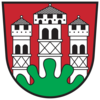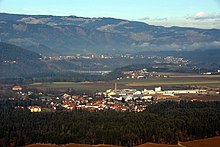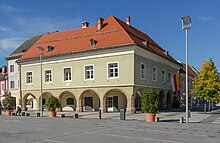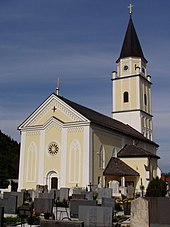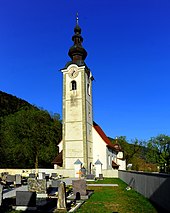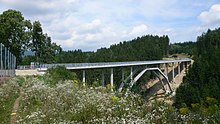Völkermarkt
|
Borough Völkermarkt
|
||
|---|---|---|
| coat of arms | Austria map | |
|
|
||
| Basic data | ||
| Country: | Austria | |
| State : | Carinthia | |
| Political District : | Völkermarkt | |
| License plate : | VK | |
| Surface: | 137.44 km² | |
| Coordinates : | 46 ° 40 ' N , 14 ° 38' E | |
| Height : | 462 m above sea level A. | |
| Residents : | 10,899 (January 1, 2020) | |
| Postal code : | 9100 | |
| Area code : | 04232 Mittertrixen: 04231 |
|
| Community code : | 2 08 17 | |
| NUTS region | AT213 | |
| UN / LOCODE | AT VOT | |
| Address of the municipal administration: |
Hauptplatz 1 9100 Völkermarkt |
|
| Website: | ||
| politics | ||
| Mayor : | Markus Lakounigg ( SPÖ ) | |
|
Municipal Council : ( 2015 ) (31 members) |
||
| Location of Völkermarkt in the Völkermarkt district | ||
 The Völkermarkt town hall, formerly Herzogburg, on the main square. In the foreground the Trinity Column |
||
| Source: Municipal data from Statistics Austria | ||
Völkermarkt ( Slovenian Velikovec ) is a municipality with 10,899 inhabitants (as of January 1, 2020) in the district of the same name in the Austrian state of Carinthia .
geography
The city is located in the south-east of Austria in the northern Jaun Valley at an altitude of 462 m, directly north of the Drau river on a striking gravel terrace that slopes steeply on three sides. On the south side is the river bed of the Drau, which has been dammed up into a long lake by the Edling river power station since 1962 and thereby flooded the Per Mostu , Mauthhaus and Fuchs settlements , which were once on the banks of the Drau.
Völkermarkt is within sight of the Karawanken in the south and the Saualpe in the northeast, whereby the city itself is located in the flat and hilly country.
Community structure
Völkermarkt is divided into the following 26 cadastral communities (with Slovenian equivalent):
- Admont-Lassein ( Volmat-Lesine )
- At the Drava ( Pri Dravi )
- Greuth ( rod )
- Gurtschitschach ( Gurčiče )
- Haimburg ( Vovbre )
- Höhenbergen ( Homberk )
- Kaltenbrunn ( Mrzla Voda )
- Little St. Vitus ( Mali Šentvid )
- Basket ( korpiče )
- Mittertrixen ( Srednje Trušnje )
- Mühlgraben ( Mlinski Graben )
- Neudenstein ( Črni Grad )
- Niedertrixen ( Spodnje Trušnje )
- Whether the Drau ( Na Dravo )
- Rakollach ( Rakole )
- Ritzing ( Ricinje )
- Ruhstatt ( Ruštat )
- St. Jacob ( Šentjakob )
- St. Peter on Wallersberg ( Šentpeter na Vašinjah )
- St. Ruprecht ( Šentrupert )
- Tainach ( Tinje )
- Töllerberg ( Telenberk )
- Völkermarkt ( Velikovec )
- Orphan Hill ( Važenberk )
- Wandelitzen ( Vodovnica )
- Vineyard ( Vinograd )
The municipal area comprises the following 79 localities (with Slovenian equivalent, number of inhabitants in brackets as of January 1, 2020):
- Admont ( Volmat ) (46)
- Aich ( Dobje ) (96)
- Arlsdorf ( Orlača vas ) (52)
- Attendorf ( Vata vas ) (51)
- Bach ( Potok ) (71)
- Berg ob Attendorf ( Rute nad Vato vasjo ) (54)
- Mount above St. Martin ( Rute nad Šmartinom ) (11)
- Mountain Stone ( Zakamen ) (49)
- Bischofberg ( Zgornja Škofljica ) (1)
- Evil Place ( Hudi Kraj ) (14)
- Dobrowa ( Dobrava ) (84)
- Drauhofen ( Dravski Dvor ) (47)
- Dullach I ( Dole pri Šentpetru ) (74)
- Dullach II ( Dole pri Tinjah ) (66)
- Drought moss ( Suho Blato ) (349)
- Frankenberg ( Brankovec ) (23)
- Guide wood ( Borovec ) (10)
- Gänsdorf ( Gosinje ) (55)
- Gattersdorf ( Štriholče ) (212)
- Gletschach ( Kleče ) (16)
- Greuth ( rod ) (225)
- Gurtschitschach ( Gurčiče ) (42)
- Harbor Village ( Čarče ) (57)
- Haimburg ( Vovbre ) (332)
- Höhenbergen ( Homberk ) (66)
- Hungerrain ( Lačni Breg ) (40)
- Kaltenbrunn ( Mrzla Voda ) (86)
- Little St. Vitus ( Mali Šentvid ) (259)
- Basket ( Korpiče ) (88)
- Kremschitz ( Hrunčiče ) (102)
- Krenobitsch ( Hrenovče ) (62)
- Kulm ( Hom ) (25)
- Ladratschen ( Tračje ) (25)
- Lassein ( Lesine ) (70)
- Lassein Bay (33)
- Lippendorf ( Lipovo ) (65)
- Mittertrixen ( Srednje Trušnje ) (153)
- Neudenstein ( Črni Grad ) (66)
- Niederdorf ( Dolinja vas ) (4)
- Niedertrixen ( Spodnje Trušnje ) (16)
- Obersielach ( Gornje Sele ) (138)
- Obertrixen ( Zgornje Trušnje ) (18)
- Oschenitzen ( Olšenca ) (138)
- Penk ( Klopče ) (18)
- Pörtschach ( Poroče ) (59)
- Rakollach ( Rakole ) (28)
- Rammersdorf ( Ramovča vas ) (75)
- Ratschitschach ( Račiče ) (66)
- Reifnitz ( Ribnica ) (101)
- Rice Village ( Rička vas ) (122)
- Ruhstatt ( Ruštat ) (56)
- Rupp area ( Pri Rupu ) (10)
- Salchendorf ( Žalha vas ) (101)
- St. Agnes ( Sveta Neža, Šentaneža ) (64)
- Sankt Georgen am Weinberg ( Šentjurij na Vinogradih ) (96)
- St. Jacob ( Šentjakob ) (156)
- St. Lorenzen ( Šentlovrenc ) (55)
- St. Margarethen ob Töllerberg ( Šmarjeta pri Telenberk ) (155)
- St. Martin ( Šmartin ) (35)
- St. Michael ob der Gurk ( Slovenji Šmihel ) (143)
- St. Peter on Wallersberg ( Šentpeter na Vašinjah ) (361)
- St. Stefan ( Šentštefan ) (31)
- Skoflitzen ( Škofljica ) (4)
- Steinkogel ( Pod Pečmi ) (34)
- Tainach ( Tinje ) (555)
- Tainacherfeld ( Tinjsko Polje ) (24)
- Terpetzen ( Trpece ) (17)
- Töllerberg ( Telenberk ) (13)
- Unarach ( Vinare ) (17)
- Unterbergen ( Podgorje ) (50)
- Unterlinden ( Podlipa ) (32)
- Völkermarkt ( Velikovec ) (4601)
- Orphan Hill ( Važenberk ) (114)
- Wandelitzen ( Vodovnica ) (28)
- Watzelsdorf ( Vacelna vas ) (77)
- Vineyard ( Vinogradi ) (39)
- Wernzach ( Brnce ) (36)
- Winklern ( Vogliče ) (26)
- Wurzen ( Gorce ) (9)
history
In the wider area there have been numerous mining sites since Roman times and the Kingdom of Noricum , but their importance has largely declined since around 1960.
A find of 237 Norican silver coins ( tetradrachms ) was made in the area of Haimburg in 1972. According to the assumption of the Austrian numismatist Robert Göbl, it was probably a treasure hiding place in the course of the Noro- Taurisk clashes or the siege of Noreia by the Boier . Göbl dates the find to around 60 BC. BC, which is, however, called into question by recent research.
Since the settlement of the area by the Karantaner - Slavs in the 6th century. and the establishment of the Carantan state in the 7th century. the area around Völkermarkt is closely linked to Slovenian cultural history. The Slovenian historical dialect spoken in the area is ascribed to the Jauntal dialect (Slov. Podjunščina ).
Around 1090, Count Engelbert von Spanheim presumably commissioned a businessman Volko from Rheinfranken to build a market settlement. Between 1105 and 1126 the place was called Volchimercatus ( Market of the Volko ), from which the name Völkermarkt developed. The Archdiocese of Salzburg founded a Ruprechtskirche at this trading center, which was located in the area of today's suburb of St. Ruprecht at the meeting of several old traffic routes . In the vicinity of this market town, the Carinthian Duke Bernhard von Spanheim had a bridge built over the Drau in 1217 and in 1231 a more strategically located settlement built, which gained city rights as early as the 13th century and benefited above all from the iron trade. The first market can be occupied for the year 1309.
In the late Middle Ages, Völkermarkt was regularly in second place among the provincial towns behind the ducal residence of St. Veit - an inner Austrian parliament was held here in 1470 - but it lost its importance in the course of the 16th century. Today Völkermarkt is the business, school and shopping center of the Jauntal, while the surrounding area is still strongly agricultural, but also increasingly touristy.
In 1880 the municipality of Völkermarkt had 2,392 inhabitants. Of these, 1,736 were German (73%) and 630 Slovenian (26%).
The organized cultural life of the Slovenes dates back to 1893 with the establishment of the Ciril in Metodova podružnica za Velikovec [branch of the Kyrill-und-Method-Verein für Völkermarkt]. The most important institution of this time was the first Slovenian Catholic private school founded on October 25, 1896 under the name Narodna šola (School of the People) in Sankt Ruprecht / Šentrupert. It was founded by the Cyril and Method Society Družba sv. Cirila in Matoda . On October 21, 1906, the Slovene cultural association Lipa (Linde) was founded, which now looks back on a tradition spanning more than a hundred years. From May 1919 to October 1920 there was also a Slovenian grammar school in Völkermarkt, which, however, was not continued after the referendum in Carinthia in 1920 despite the obligations under the Treaty of Saint Germain .
In the course of the Balkan campaign of the German armed forces in 1941, 60,000 Slovenes had been deported from the occupied Slovenian / Yugoslavian Lower Styria . In April 1942, Slovenes from Carinthia a. a. Deported from the Völkermarkt area, which subsequently led to organized armed resistance , which contributed to the military liberation from the Nazi reign of terror and to the rebuilding of Austria.
The Saualpe north of Völkermarkt was also a center of this armed resistance ( partisanism ) . “To commemorate the partisans who fell on the Saualpe - members of eight nationalities - the Carinthian partisans unveiled a memorial in St. Ruprecht near Völkermarkt in 1947 in the presence of representatives of the Allies . The monument is a symbol of the Carinthian and international struggle against fascism . Unknown perpetrators blew it up on the night of September 10-11, 1953. The Austrian authorities did not restore the monument in its original form, which is why the Association of Carinthian Partisans restored it in 1983 and erected it in front of the Peršmanhof Museum in Leppen (market town of Bad Eisenkappel ). "
On September 18, 1979, the town hall of Völkermarkt, in which there was an exhibition on the Carinthian defensive battle , was the target of a terrorist attack by the Yugoslav UDBA in which the two Slovenian agents seriously injured themselves and a museum employee. The agent Luka Vidmar lost a leg. A hole was torn in the facade of the town hall. The two UDBA agents were sentenced to four years' imprisonment in 1980, but six months later they were exchanged for two agents from the Austrian Abwehramt . The Völkermarkt attack was the last in a series that began in 1972.
With the creation of local parishes in 1850, Völkermarkt was set up as such. In 1973 the municipalities of Sankt Peter am Wallersberg, Waisenberg , Tainach and Haimburg were united with the city in one large municipality, the population of which roughly doubled due to the now almost 80 villages.
population
At the time of the 2001 census, Völkermarkt had 11,373 inhabitants, of which 93.9% were Austrian, 1.5% Bosnian and 1.0% Croatian and 3.6% of other nationalities.
Population development
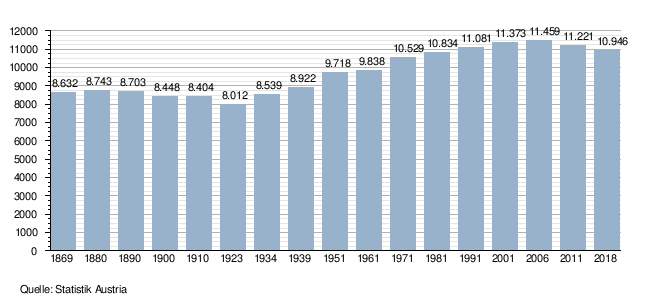
Language and religion
In the referendum of 1920, thanks to the Slovenes who voted for Austria, the majority of the south-east of Carinthia voted for remaining with Austria (Völkermarkt district: 8306 for German Austria, 2444 for the SHS state). In 2001, 292 inhabitants (2.6%) were Slovene-speaking.
In 2001, 89% of the community population committed to the Roman Catholic Church , 3% to the Evangelical Church and 1.5% to Islam . 5% described themselves as non-denominational.
The following Catholic parishes and branch churches are run bilingual German-Slovene in the deanery Völkermarkt: in Diex the branch church St. Michael im Graben / Šmihel , the parish church Gorentschach / Gorenče and the branch church St. Radegund / Št. Radegunda , the parish church Greutschach / Krčanje , the parish church Haimburg / Vovbre , the parish church Ruden / Ruda including branch churches Lind / Lipa and Lippitzbach castle chapel / Lipica-grajska kapela , in Töllerberg the branch churches St. Franzisci / Želinje and St. Katharina am Kulm / Sv. Katarina na Homu , the parish church of St. Peter am Wallersberg / Št. Peter na Vašinjah including the branch churches Lisnaberg / Lisna gora , St. Lorenzen / Šentovrenc and St. Martin / Šmartno , the parish church of St. Ruprecht near Völkermarkt / Št. Rupert pri Velikovcu including the branch churches St. Agnes / Sv. Neža and Ortisei / Št. Urh , in Stift Griffen the old parish church / Stara farna cerkev including the branch churches Dürrenmoos / Suha Blato , Gletschach / Kleče , St. Michael in Unternberg / Šmihel v Podgori and Wallersberg / Vašinje as well as in the deanery Tainach / Tinje the parish church Tainach / Tinje including the Branch churches Wabelsdorf / Vabnja vas and Eiersdorf / Virna vas .
Culture and sights
The “District Home and City Museum” gives an insight into the history, culture and customs of the Völkermarkt district as well as the events of the Carinthian defensive struggle and the referendum in the years 1918 to 1920.
Two galleries , the Heunburg Theater and regular events round off the cultural scene in the city center. In addition to the Bürgerlustpark and open-air concerts, the large weekly market should also be mentioned. The area offers churches, castles and other cultural monuments, for example the Haimburg castle ruins .
Economy and Infrastructure
Market system
Trade is traditionally the most important economic factor for the city. As of 2005, the “Urban Development Offensive” and the Chamber of Commerce established a fresh market on Friday and an “ EU nation market” in addition to the Wednesday market. There are also special Easter markets for Alps-Adriatic themes and a fish market.
The following markets are currently held regularly in the city:
- Weekly market - the traditional weekly market takes place every Wednesday.
- Nikolomarkt - the traditional Nikolomarkt takes place every year on the first Monday before Nicholas in December.
- Junk market - a market for used items founded as part of the urban development offensive. It has been held every last Saturday of the month since April 30, 2005.
- Christkindlmarkt - the Christkindlmarkt takes place in December on the lower main square.
- Völker Markt - a fresh market, presented for the first time on September 30, 2005.
tourism
Tourism is an important pillar of the Völkermarkt economy. The city hosts over 20,000 guests annually. The bathing lakes Klopeiner See and Turnersee southwest of Völkermarkt are significant for this .
The possible sports and leisure activities for guests include: a. Fishing at the Völkermarkt reservoir , swimming in the Völkermarkt adventure pool and other types of water sports, cycling (the 366 km long Drau cycle path leads past the outskirts) and hiking. In the wider area of Völkermarkt there is also a ski area on the Petzen ( 2126 m ).
traffic

On the northern edge of the Jaunfeld , the city of Völkermarkt is located on two intersecting traffic routes that have existed since the Middle Ages :
- The Drau, which today is dammed up at Völkermarkt to become the Völkermarkt reservoir
- The traffic route running from the south (the Seebergsattel in the Karawanken at 1220 m ) to the north (the Noric region ), which was previously heavily used because of mining ( iron , lead ).
Today Völkermarkt is on the southern motorway with the junctions Völkermarkt West and Völkermarkt Ost . A new Völkermarkt Mitte connection is to be built at the intersection with Seeberg Strasse B 82 by 2013 . Packer Straße B 70 is a busy road . In April 2010 the Völkermarkt bypass was completed and opened to traffic.
The Drautalbahn (formerly Franzensfeste / Fortezza (South Tyrol) - Lienz - Spittal - Villach - Klagenfurt - Bleiburg - Maribor / Marburg ) runs five kilometers south of Völkermarkt in the municipality of Eberndorf. The station is called Völkermarkt-Kühnsdorf, but it cannot be described as a direct railway connection. Völkermarkt is therefore the only district town in Austria that has never had a rail connection. Originally, when the railway was planned in the 1860s, the idea was to develop Völkermarkt directly, but at that time a strong wagon lobby opposed the construction.
The importance of the Maribor – Klagenfurt railway line, although still the main railway line, fell sharply due to the assignment of territory to Yugoslavia in 1918 ; In 1964 the Jauntalbahn was completed as a replacement . In the next few years, the Koralm Railway is expected to provide a further economic boost to the region.
politics
Municipal council
The municipal council has 31 members and has been composed as follows since the 2015 municipal council election :
The city council (city government) of Völkermarkt has seven members.
mayor
- 1991-2020 Valentin Blaschitz (SPÖ)
- since 2020: Markus Lakounigg (SPÖ)
coat of arms
| Blazon : "In red behind a fivefold green waves crest three silver bezinnte towers with conical roofs growing ." | |
| Foundation of the coat of arms: The oldest city seal has a diameter of 60 mm and is preserved in a document dated July 1, 1267. Both Schildfuß , whose crest suggests the banks of the Drau rather than the hilly surroundings, and the three towers, which represent the two city towers in the west and east, in between probably the prince's castle, showed strong deviations as a result. For the 1974 coat of arms certification, however, the oldest depiction from 1267 was used. |
The flag is red-white-green with an incorporated coat of arms.
Personalities
- Markus Hansiz (April 25, 1683 - September 5, 1766), Jesuit and historian
- Maximilian Joseph Gritzner (born October 13, 1794 - † August 27, 1872), industrialist and member of the Frankfurt National Assembly
- Johann Peyritsch (born October 20, 1835 - September 14, 1889), botanist, physician and university professor
- Hermann L'Estocq (born June 20, 1887 - † June 16, 1940), district captain of Völkermarkt and victims of National Socialism
- Julius Ringel (born November 16, 1889 - † February 11, 1967), general of the mountain troops of the Wehrmacht
- Rudolf Giendl (March 5, 1894 - April 4, 1971) architect
- Victor Sokolowski (born February 13, 1911 - September 6, 1982), harpsichordist, pianist, organist and music teacher
- Franz Yang-Močnik (born June 1, 1951), visual artist
- Stefan Karner (born December 18, 1952), historian
- Edwin Wiegele (born August 20, 1954), visual artist
- Brigitte Karner (born December 12, 1957), actress
- Robert Mack (born July 1, 1959 - † July 4, 2020), ice hockey goalkeeper
- Sabine Ladstätter (born November 22, 1968), classical archaeologist
- Julia Cencig (born September 18, 1972), actress
- Stephanie Graf (born April 26, 1973), track and field athlete
- Elmar Lichtenegger (born May 25, 1974), athlete
- Herbert Ratz (born September 16, 1981), ice hockey player
- Tanja Raunig (born May 3, 1989), actress
- Magdalena Lobnig (born July 19, 1990), rower
literature
- Karl Wit: Völkermarkt, chronicle of the large community. Self-published by the city of Völkermarkt, Völkermarkt 1980, OCLC 719260365 .
- Günther Körner (Ed.): 750 years of the city of Völkermarkt. Contributions to the past and present of Völkermarkt. Edited by Günther Körner. Self-published by the city of Völkermarkt, Völkermarkt 2001, ISBN 3-85391-190-0 .
Web links
- Municipality of Völkermarkt
- 20817 - Völkermarkt. Community data, Statistics Austria .
Individual evidence
- ↑ Franziszeischer Cadastre near Kagis.
- ↑ a b According to Paul Zdovc: Slovenska krajevna imena na avstrijskem Koroškem, razširjena izdaja. They Slovenian place names in Carinthia. Ljubljana 2010.
- ↑ Statistics Austria: Population on January 1st, 2020 by locality (area status on January 1st, 2020) , ( CSV )
- ^ Robert Göbl: The Noric tetradrachm find 1972 from Haimburg in Carinthia: attempt at a total reconstruction. Vienna, 1989.
- ^ Susanne Sievers , Otto Helmut Urban , Peter C. Ramsl: Lexicon for Celtic Archeology. A – K and L – Z. Communications from the Prehistoric Commission. Publishing house of the Austrian Academy of Sciences, Vienna 2012, ISBN 978-3-7001-6765-5 , p. 719.
- ^ History. Historical development of the city of Völkermarkt. In: Website of the municipality of Völkermarkt. Retrieved November 22, 2019 .
- ↑ KK Statistische Central-Commission: Special-Orts-Repertorien of the kingdoms and countries represented in the Austrian Reichsrathe. Volume V: Carinthia. Vienna 1883, p. 88.
- ^ Association of Carinthian Partisans ( Memento from August 21, 2011 in the Internet Archive ). In: slo.at, August 21, 2011, accessed on November 20, 2019.
- ↑ Text taken from the inscription on the monument at Peršmanhof , cf. also: Peršman Museum ( Memento of 27 August 2011 at the Internet Archive ). In: bad-eisenkappel.info, and The massacre at the Peršmanhof 1945. International workshop, Klagenfurt / Celovec 6./7. November 2003 ( Memento of February 11, 2004 in the Internet Archive ). In: persman.at .
- ↑ The goal was to divide Carinthia. ( Memento from September 27, 2014 in the Internet Archive ) In: Kleine Zeitung , August 14, 2009.
- ↑ The 30th anniversary of the bombing. (No longer available online.) In: kaernten.orf.at. ORF Carinthia , September 17, 2009, archived from the original on December 19, 2015 ; accessed on November 22, 2019 .
- ↑ See list of parishes in the deanery Völkermarkt / Velikovec on Wikipedia
- ↑ BMVIT , accessed on November 12, 2010.
- ↑ Local council election March 1, 2015. In: info.ktn.gv.at. Office of the Carinthian Provincial Government, accessed on November 22, 2019 .
- ↑ Valentin Blaschitz. Biography on the website of the Austrian Parliament. Retrieved December 2, 2016 .
